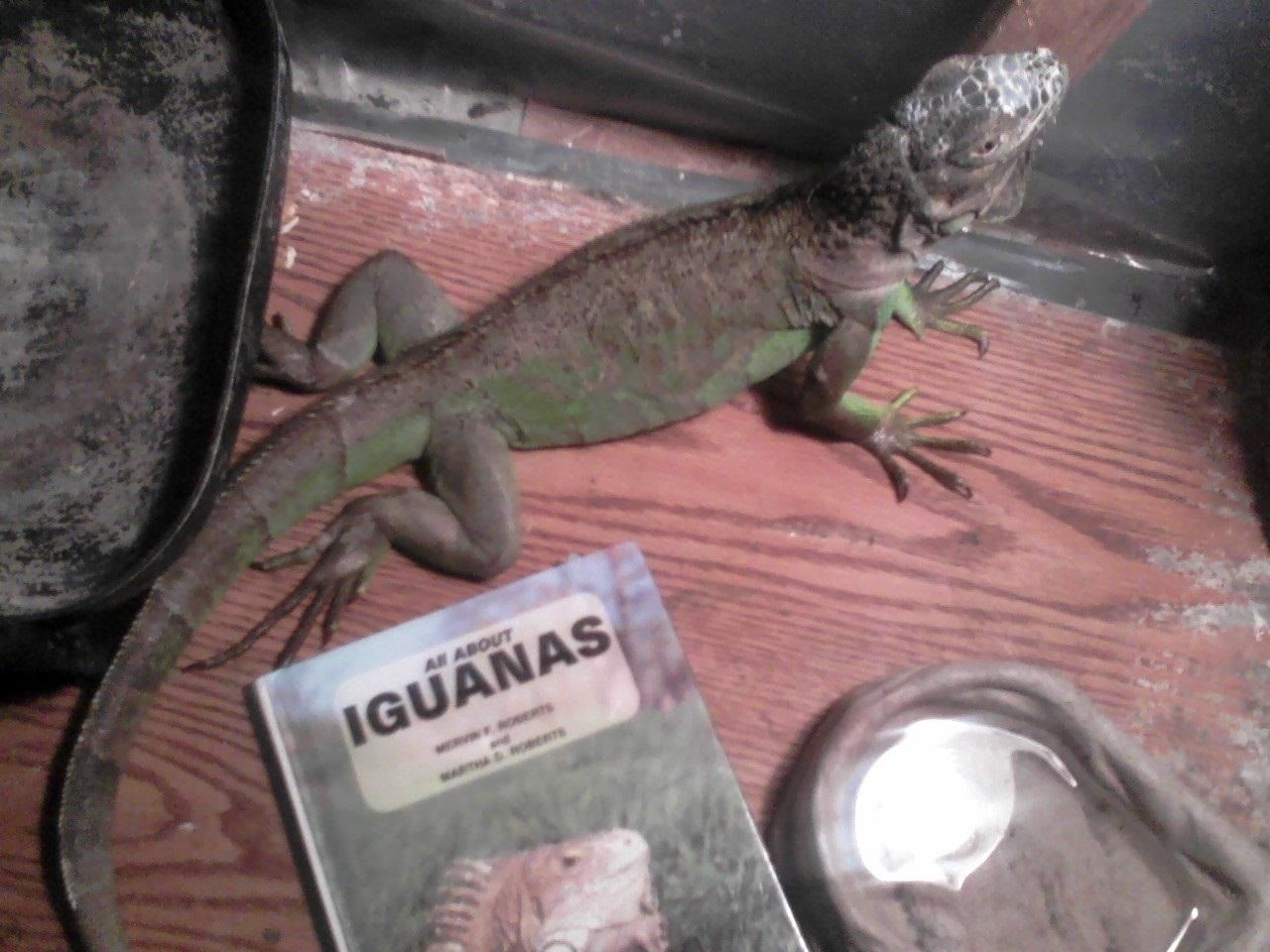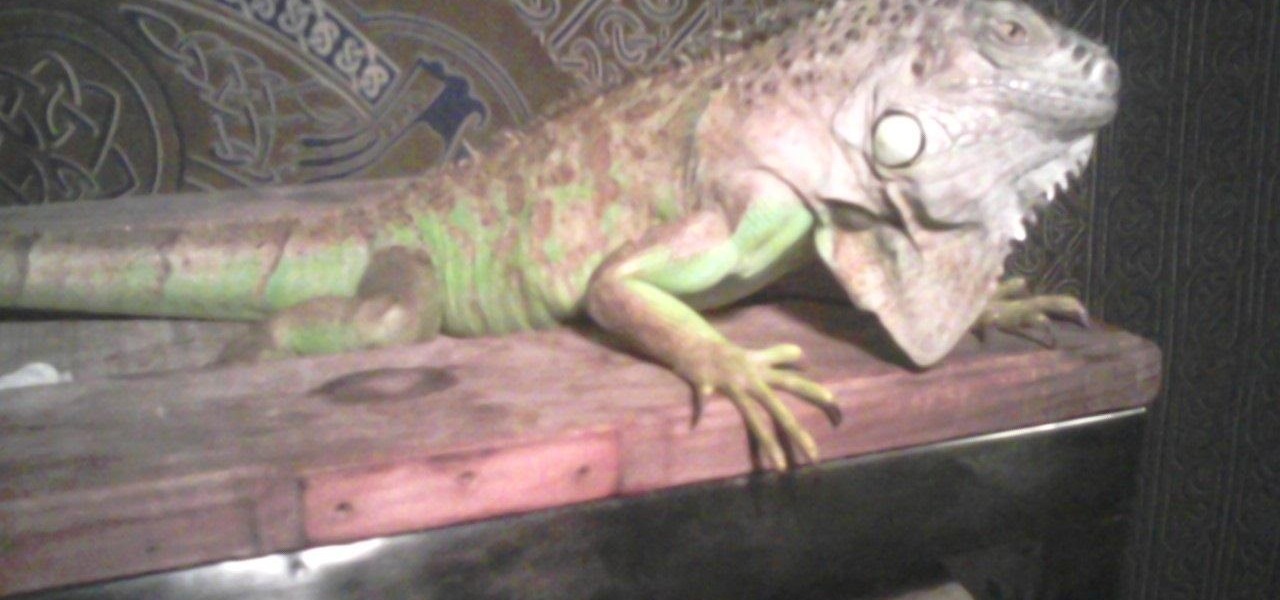First of all, I would like you all to meet my good friend Iggy.

There he is, in all his scaly reptilian glory. As you can see, he spends a lot more time on top of his cage than inside of it. You see, Iggy here doesn't deal well AT ALL with confinement. I don't know if it's possible for a lizard to be claustrophobic, but if it is possible, then Iggy definitely is. When his previous owner gave him to me, I tried to keep him in the cage, but I quickly realized that it was a bad idea. When confined for any lengthy time period, he digs at the cage, flings himself at the glass, and starts furiously attacking ANYONE who gets near him. Then, as soon as you do open the cage, he jumps out and bolts for the nearest hiding spot, and when you try to catch him it's like trying to hold onto greased lightning with claws and teeth. This, by the way, is why his previous owner gave him to me. But guess what? Once I gave him a little more freedom, he calmed right down.
With this article, my aim is to convince all the other Iguana owners out there to try the cageless approach to Iguana-keeping, especially if your Iguana is a rowdy one like Iggy here.
Ok, let's start by going over the benefits of this approach:
- Your Iguana will be much happier, and much more fond of you as a result.
- Your Iguana will show a lot more personality. Captivity dulls the mind, whether it is a human or an animal in captivity. Most pet lizards just sit in a cage all day and do nothing except eat and sleep. But if you spent your whole life in solitary confinement, you wouldn't feel too energetic either! Let your lizard roam free and you will see just how smart and personable they really are.
- You will be interacting with your pet much more, because you will be sharing a room. To be honest, if you don't want to interact on an everyday basis with your Iguana, you should not have one.
- When you let them run loose most of the time, you can use the cage as a punishment, which allows you to train your lizard in ways you normally could not.
Now let's look at the downsides:
- You will have to change your habits a little bit to adjust for your new roommate. Things like keeping the door shut and not leaving any toxic substances lying around for them to eat...mostly very small matters.
- Although you can housebreak an Iguana, there still may occasionally be accidents...so you should be prepared to clean up some lizard poo once in awhile...of course, this is something you are going to have to deal with anyway, cage or no cage.
- They will occasionally knock things over as they crawl and climb around your room. You will need to rig your breakables so that they cannot easily be knocked over. This can be aggravating, but it's a minor inconvenience.
OK, now that you understand the basic idea, let's go over the process of going cageless:
Step 1: Set Up a Living Space:
You should begin by setting up a living space for your Iguana. This is just a place where you set up their heat light, water dish, and crap pan. Iggy's living space is on top of a wooden cabinet:

It's about two feet off the ground. Now, naturally, you will need to create an easy way for your Iguana to get up and down from here. I just took a 2x4, wrapped it in burlap, and tied it against the side. This gives him a post that he can climb with no trouble at all. Notice that his water dish is of a type which is almost impossible for him to spill. This is important because Iguanas have a real knack for spilling water dishes.
The black thing to Iggy's left is his crap pan. This is where he leaves his dirty deuces. He is housebroken, and soon your lizard will be too, provided you follow these instructions well.
Of course, like any reptile, he needs a heat bulb. Iggy's heat lamp is clamped to a small piece of wood above him:

This light is set on a timer to give him 12 hours of day, followed by 12 hours of night.
This is about all your Iguana really needs for his living space. You may choose to give him an enclosed "cave" area but it isn't necessary. He will find good hiding spots either way.
Since most of what your Iguana needs is right here, your Iguana will spend the majority of their time right here.
Step 2: Iguana-Proof Your Room
Ok, now that the living space is set up, you need to go through your room with a fine-tooth comb and make it Iguana-proof. The 2 main goals are to remove any hazards to him, and to make it difficult/impossible for him to destroy your property.
So first, make sure anything that could poison him is put away where he is completely incapable of getting to it. Cleaning products, hygeine products, pesticides...anything toxic. Do not underestimate the ability of an Iguana to climb and jump. If your room has any of these things in it, my advice is to get a big plastic tub with a lid and keep them there. Then, look around for sharp objects. Anything that will cut your lizard should be hung up on the wall or put away.
Next, you will need to consider any breakables that might be in your room. This includes anything made of glass or ceramics. One easy way to put these breakables out of reach is to put them in a cabinet with a closed door. Another way is to put them on a high shelf, such as the one I use for this green electric thing:

Iggy cannot get up here, and that is good, because I know full well that he would knock down that cool green electric thing (which is made of glass) and break it for sure.
Yet another way is to hang the breakables themselves on the wall, rather than putting them on a shelf. As long as you make sure there is no way whatsoever for the lizard to climb up to them, they should be fine.
Speaking of climbing, you should give your lizard some good stuff to climb on. I have a bunch of cloth wall hangings that he likes to scale. This will help to keep him from climbing where you don't want him to. And another thing about climbing: they cannot climb a smooth surface, so use this to your advantage! For instance, I have a glass-top table that I keep a lot of odds and ends on. Iggy can't climb up there (trust me, he has tried!), so I know he can't run and climb over my stuff and scatter it everywhere.
Take the habits of your lizard into account. For instance, Iggy really likes high places, so I keep those areas clear for him.
This step will be a little different for everyone, of course. Be sure to take your time and consider every possibility. It will save you a lot of aggravation later on.
Step 3: Change Your Habits
There is much more to going cageless than just opening the cage and letting him do this thing. You need to get him used to this new way of living, but first you need to get yourself used to it.
Here are the rules you will need to follow at all times:
- Always keep the door to the room closed. If anyone else lives with you, make sure they know to do the same.
- Watch where you step. Lizards are pretty fast, and thus pretty able to avoid your feet, but take care all the same.
- Never use any pesticides or toxic cleaning chemicals in that room.
- You will need to keep the room as warm as you can. A small space heater might be required. Remember, Iguanas are tropical creatures! Always remember, if the room feels cold to you, it probably feels twice as cold to your lizard.
- Never leave a plate of food unattended in your room.
Not so bad, right? I do all four of these things all the time, and I don't even think about it anymore. It just becomes habit.
Now you are ready to open the cage and let the lizard out. Chances are, they are going to bolt for a good hiding spot and stay there for awhile. Don't worry about it. They will come out when they are ready.
When they finally do, you should immediately feed them. Put some food in their living space, turn on the heat light, and put water in the dish.
Let's take a moment to talk about handling. Iguanas need to be picked up and handled in a completely non-forceful way. Never, ever grab the lizard unless you are snatching them up to put them in the cage. Instead, use this process:
- Reassure your Iguana that you mean them no harm by stroking their neck like so:

- slide your hand underneath them, just under their front feet:

- Slide your hand forward and up, allowing them to pick up their front feet and set them on your hand:

- Now slowly lift up your hand, and let the Iguana raise his back feet and put them on your arm:

If he tries to keep walking, just let him walk from one hand to the other until he settles.
The point of this is to handle your Iguana with as little force as possible. This is a respect thing. You are giving him a chance to refuse you. If he does not want to be held, he will not climb up on your arm. You need to respect that and leave him alone when he wants to be left alone. If you try to stroke their neck, and they start shaking their head around, it means they don't want to be bothered so once again, respect that and leave them alone.
So, now that you know how to pick up your Iguana without pissing him off, pick them up and place them in their living space, right under the heat light. Now feed them and offer them water:

A word about feeding: DON'T FEED YOUR IGUANA THAT CRAP THEY SELL IN THE PET STORES!!!!!!! The good lord made Iguanas to eat leaves, fruit, and occasionally meat and bugs. So give them what nature would give them! Most of those commercial Iguana diets have all sorts of unnatural substances added to them. Read the ingredients if you don't believe me.
I do use a calcium supplement, but you really need to be careful here. Always read the ingredients! What you want is Calcium Carbonate and little to nothing else. I use this kind:

Its ingredients are Calcium Carbonate and vitamin D3, which is acceptable because it is a natural, nontoxic substance. This stuff is good for an Iguana but don't use as much as they tell you to! This little packet is supposed to be ONE DOSE, but it has lasted me 5 months. This is because I don't give it to him every day, and I only give it to him in very tiny amounts. To give it to your lizard, just take a pile of wet collard greens and sprinkle a tiny dash of the powder onto them. I have had lizards die before because they were given too much calcium, so I only give Iggy the calcium once every two weeks.
Now, we must train your Iguana. This will be a little more difficult.
Step 4: Training Them to Stay in the Room
Even if their room contains everything they need, your Iguana will still be curious about what is outside the door. You don't want them bolting for the door every time you open it, because that is both an annoyance and a danger.
First, turn off the heat in your house. Then, go to the Iguana's room and plug the heater in. Now, turn that heater up all the way. Get it nice and toasty in the Iguana's room, and real cold in the rest of the house. Now, put the Iguana on your shoulder and walk him outside the room. If you keep any dogs, make sure your Iguana sees them. Never feed him or give him water outside of that room. Needless to say, if you have dogs, you need to train them to never go in that room at all.
The point of all this is to make your Iguana see the outside as a place that is cold, full of monsters, and devoid of anything he likes. After this, I can actually leave the door to my room open and he will not leave. I try to always keep the door shut but mistakes will happen.
If he still won't quit bolting for the door, then you must resort to more drastic measures. Everytime he runs for the door, snatch him up and put him in the cage for an hour or two. After awhile, they will figure it out and stop doing the thing that gets them caged.
Step 5: Housebreaking
This is the part that most people have trouble with, but it is actually pretty simple. As you can see here, Iggy takes his dumps in a square black pan that used to be an electric skillet.

You may notice I have placed it right next to his basking spot. This is because reptiles use heat to digest their food, so having the bathroom next to the sun lamp makes it easier for them to do what you want.
The first step is to simply make your Iguana poo in the pan. To do this, start by feeding him a big meal. Feed him until he won't eat any more. Then, keep an eye on him. An Iguana will usually go to the bathroom within 20 minutes of eating a large meal. When you see the lizard assuming the position and getting ready to drop a deuce, pick them up and put them in the pan. Gently hold them in place so they don't move. Since they are trying to lay a big one right now, they will be less likely to run away.
Once they have pooped where you want them to poop, reward them by stroking the back of their neck, stroking under their chin, and offering them a treat. Speak to them in a reassuring tone and tell them that they are a good lizard.

As for the treat, my Iguana goes nuts for pineapples, pears, and especially red meat. In fact, he has stolen entire steaks off my plate while I wasn't looking! If they don't eat the treat, show it to them. Put it right up to their nose so they know it is there, and if they still don't want it, just leave it for them to have later.
That is the positive-reinforcement side of the training. Now, let's talk about the negative-reinforcement side.
As I said before, you can use the cage as a punishment when your lizard breaks the rules. So, whenever they poop out of place, snatch them up and put them in the cage for an hour or two. Be aware that they will fight you tooth and nail (literally), so be prepared for a few scratches.
Once again, don't expect the training to take effect right away. It will take time, patience, and firmness. After awhile, your lizard will figure out that you are very happy when he craps in one place, but very angry when he craps anywhere else. Iguanas, by the way, have a natural instinct to dump in the same place over and over, much like a cat does. Once it becomes a habit for them to drop mud in that one spot, they will usually continue to do it.
One other little tip: Whenever they poo in the right place, clean it up immediately. Otherwise they will not want to use it the next time they take a dump. They like to have a clean place to crap just like you do!
Anyway, that about wraps it up. As you can see, going cageless is not that hard. Once you have your room set up properly, and your Iguana trained to do two things (stay in the room and crap in one place), the work is all done. From there, you just have to feed them, give them water, give them a little calcium once in awhile, and pay attention to them. If you are an Iguana owner, and your Iguana spends their life in the cage, I implore you to set them free! They will be happier, healthier, and more outgoing. Freedom is the natural way for all god's creatures to live, so give them as much as you can, and you will be rewarded with a happy, wonderful pet that you can interact with all the time. Isn't that better than having a pet that just sits in a cage and looks pretty?

Just updated your iPhone? You'll find new emoji, enhanced security, podcast transcripts, Apple Cash virtual numbers, and other useful features. There are even new additions hidden within Safari. Find out what's new and changed on your iPhone with the iOS 17.4 update.

































10 Comments
Red meat and bugs? Are you an idiot? Iguanas cannot digest animal proteins, it causes organ damage and potentially other major problems.
My iguana is 3 years old, is 7 feet long and weighs 20 pounds. Eats nothing but organic fruits and veggies, in the summer she has her own garden full of fresh fruits and veggies. She hasn't been caged kept since she was 3 months old. She has her own bedroom and free roam of the house.
Wow! I thought thst was a really nice article and you go calling the guy an idiot? You must be some kind of holier than thou type person! I get it that they aren't supposed to eat meat but how about offering the guy some advice instead of being so mean? I would listen to someone who's giving constructive criticism before someone who is acting like a know it all. Nobody knows everything and its great to learn new information.....but you dont have to be so hateful when sharing your knowledge. He was just trying to help...what were you doing?
Agreed!! Also nothing in here talks about humidity! Which is very important for an iguanas help. No meat, and a proper humidity level is needed
The article is reasonable.
Think about it. An iguana forges and nibbles all day in the tree tops of a biologically diverse region such as... Costa Rica. Would he not accidentally ingest a Miriad of insects or their eggs attached to those tree top choices?
And if you try to feed an iguana a green onion, it will shun it. The know what their dietary needs are and arnt. Better than we do our own.
Just food for thought genitalmen. From an award winning professional in the industry.
I loved this article, very well written and funny. My Iguana was very aggressive until we let him roam. I put him in the bathtub and run warm water on him at bathroom time, works instantly. (and yes iguanas are omnivores when mature)
Hello. My boyfriend and I split and for the safety of the iguana he left him with me instead of living from house to house or on tje streets with him. But while he was here I relied on him to pick the iguana up and hand him to me. I've been afraid of the iguana since he bit my ex once when we first got him and I've seen videos of iguanas tearing someones hand up but I also see videos of nice timid iguanas. My is very nice timid and smart. It's like he looks at me and wants me to get him and pet him and he climbs up on my lap sometimes. What makes me afraid the most is if he smells my fear and gets him fearful. Also when he becomes mature like 7 years old they say they turn on their owners. But mine is like 1 year old. Ironically his name is Iggy My Ziggy. Can anyone help.me not be afrad to approach him and pick him up?
If he wanted to hurt you he would have , body language is a big deal with iggs and thay are good at telling you how thay feel especially if thay are upset . Just remind yourself he loves you and wants your attention and will be sad without it , thay do need interaction or thay can get very depressed . If he doesn't want touched he will puff up , hiss, tail whip, avoid you and your hand and possibly open mouth and threaten a bite but i don't think yours will as you discribe him as pretty tame so you will likely just have him enjoy being pet and as far as him biteing once chances are he was telling you he was upset and did not get listened to it happens pretty often as most people don't speak iguana very well :) but you will want to KEEP him tame before he hits breeding age he may get grumpy in breeding season but you won't know until you try and if you don't try your just setting him up to fail . If he does get some male mocho going on you can try to give him a stuffed animal to take it out on , it sounds weird but works more often than you would think but be warned you my walk in the room and get an eyefull of flurting lol or he may just attack it ether way he gets it out of his system a bit . I hope this helps just remember to try he will be happyer
I didn't see anything about having humidity, or having a fogger or humidifier... Only says "offer water" and I also have been told that they shouldn't eat meat. But who knows, everyone has different views. But this guy looks like he has only had an iguana for a few years... So I'm not trusting what he says completely. Also again back to the point that he never mentioned misting, spraying, or anything...they need humidity, how does he keep humidity in the room
I have a question i have a male an female iguana an there still real tiny i have small chiwawas aswell how big should i let tge iguanas get b4 i can start allowing them to live cageless ?
Hi – I 'have' two pet Iguanas or monitor lizards – not sure which. – I live out in 'the bush' in Kenya and they just come and visit – out of the wilds.
At first there was just one – about 3 feet long - who came and shared the cat's food, especially omena, tiny dry fish, I give them.
The other day it came with another, much bigger, one – about 4 feet long and a couple of inches wider.
This one came further into the house and hung-out for a couple of hours under a bookshelf behind a heap of old carpet, but then left.
I am thinking that maybe this one, being bigger, was the female and was maybe checking out a place to have babies in!
Does anyone know how many babies they have at a time? Do they have eggs that then hatch?
Share Your Thoughts